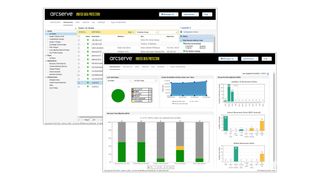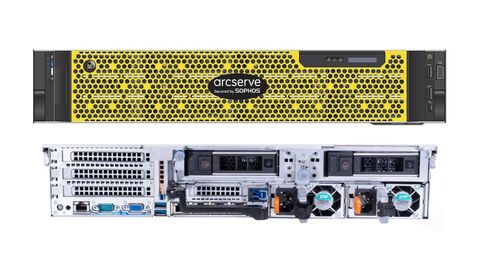IT Pro Verdict
Pros
- +
Excellent backup and recovery features
- +
Swift deployment
- +
Easy management
- +
Unlimited client and app support
- +
Top-notch Dell hardware
- +
High storage capacity
Cons
- -
Complex Microsoft 365 authentication process
Purpose-built backup appliances are a great choice for businesses that want all their data protection and disaster recovery services in one place - and they don’t come better equipped than Arcserve’s 9000DR series. On review is the high-end 9288DR Appliance, which combines a quality Dell PowerEdge R740xd rack server platform with a high storage capacity and all the backup and recovery features you can eat.
The 9288DR Appliance has Windows Server 2019 at the helm and comes with Arcserve’s UDP (Unified Data Protection) software preinstalled. The latest UDP 8.1 adds plenty of new features including multi-factor authentication (MFA) for tighter access security to its management console and an increased focus on protecting Microsoft 365 users with added support for OneDrive, SharePoint Online, Microsoft Teams and Office 365 Groups.
Every business requirement is covered, as along with support for physical and virtual environments plus a wealth of business apps, UDP provides global deduplication and replication as standard features, plus optional high availability. Malware gets short shrift too, as Arcserve includes the Sophos Intercept X Advanced for Servers endpoint protection software on the appliance.
Arcserve 9288DR Appliance review: Setup and configuration
Deployment is swift. On first boot, the system sets up Windows Server 2019 and then runs a wizard for UDP that helps configure the network ports, join the appliance to an Active Directory (AD) domain, add member nodes and create the first protection plan. We opted for a standalone recovery point server (RPS) after which the wizard created a default data store on the appliance’s RAID6 array for backups and enabled global deduplication, compression and AES-256 encryption.
Individual nodes have the UDP agent automatically pushed to them and to declare our virtual machines (VMs) for agentless backup, we used the import option to browse our Hyper-V and VMware vSphere hosts and add selected VMs. Protection plans make it easy to manage your backups as you define schedules which can be as often as every 15 minutes and set the number of recovery points required.

Plans are provided for agent-based backups of Windows and Linux systems, host-based agentless backups, securing UNC or NFS shares plus Microsoft 365 Exchange Online, OneDrive and SharePoint Online services. UDP’s infinite incremental strategy is easy to manage, as it defaults to running a full backup followed by incrementals which only copy changed blocks.
Arcserve 9288DR Appliance review: Task management
Protection plans are extremely versatile, and we could add extra tasks to them as and when required. These include options for replication to a remote RPS, provisioning a virtual standby VM, running an assured recovery test, copying recovery points to a network share or cloud storage account and migrating data to a tape drive attached to another host running the Arcserve Backup software.
When copying recovery points to cloud storage, you can currently choose from 14 providers including AWS S3, Microsoft Azure, AppScale, Nutanix and Cloudian. The optional Arcserve Cloud storage service can also be used to create a remotely managed RPS for replication.
We used our live Microsoft 365 Exchange Online account for testing but authenticating it with UDP is a laborious process and we ended up requesting a remote support session to save time. Once this was correctly configured, we could then create a new plan, browse our Exchange Online users and groups and select those we wanted to protect.
The appliance’s Sophos endpoint protection agent is remotely managed from the Sophos Central cloud portal and takes all its security policies from here. Suffice to say that we’ve used the Central portal and Intercept X software for a number of years to protect our lab systems and rate it highly.
Arcserve 9288DR Appliance review: Recovery process

For file and folder recovery, we loaded the UDP agent’s console for the selected node, chose a recovery point, picked files and folders and restored them back to the node or another location. Users can also do this themselves as from the UDP console, we could mount node recovery points as local drives on their system for drag and drop restores.
When the agent was installed on our SQL Server host, it automatically added its databases as backup sources and we had no problems restoring these back to the host. We had no issues with Exchange Online recovery either; we chose a user from the local UDP agent, browsed their folders, selected the required items such as a specific email in their inbox, and restored them back to the user’s account.
The Instant VM feature is great for fast system restores, creating on-demand VMs from node recovery points. Using our SQL Server node to test this, we selected the Instant VM option, chose a recovery point, used the appliance’s Hyper-V services and had a new VM up and running in only 210 seconds.
And if you want to know that Instant VM will work when you need it most, you can add an assured recovery task to a plan. After each backup, it loads a temporary VM on the designed virtualization host, confirms it’s working correctly, closes it down and deletes it.
UDP’s global deduplication and compression are also very efficient: over a one month testing period, we secured a total of 1.9TB of data from all our nodes. We could see from the console’s data distribution reports that this had been squashed down to only 304GB, returning an impressive 84% data reduction.
Arcserve 9288DR Appliance review: Verdict
Microsoft 365 authentication needs simplifying, but Arcserve’s 9288DR Appliance delivers perfect protection for any physical and virtual environment. Presented on a quality hardware platform with a big backup capacity, it’s swift to deploy and simple to manage - any product that makes enterprise backup and recovery this easy deserves our Editor’s Choice award.
Arcserve 9288DR Appliance specifications
| Chassis | 2U Dell PowerEdge R740xd rack server |
| CPU | 2 x 10-core 2.2GHz Intel Xeon Scalable Silver 4114 |
| Memory | 192GB 2,400MHz ECC DDR4 (max 1.5TB) |
| Storage bays | 18 x hot-swap LFF SAS/SATA (12 front, 4 mid-plane, 2 rear) |
| RAID | Dell PERC H730P Mini with 2GB cache and BBU |
| Storage included | 10 x 12TB Dell SAS3 HDDs (RAID6), 2 x 1.92TB Dell SATA SSDs (RAID1) |
| Other Storage | Dell dual-port SAS3 PCI-E HBA |
| Network | 4 x Gigabit |
| Expansion | 4 x PCI-E 3 (3 free) |
| Power | 2 x 750W Platinum hot-plug PSUs |
| Management | UDP web console, Dell iDRAC9 Enterprise |
| Warranty | Arcserve 1-yr Gold support and maintenance, Dell 3-yr ProSupport NBD |
Dave is an IT consultant and freelance journalist specialising in hands-on reviews of computer networking products covering all market sectors from small businesses to enterprises. Founder of Binary Testing Ltd – the UK’s premier independent network testing laboratory - Dave has over 45 years of experience in the IT industry.
Dave has produced many thousands of in-depth business networking product reviews from his lab which have been reproduced globally. Writing for ITPro and its sister title, PC Pro, he covers all areas of business IT infrastructure, including servers, storage, network security, data protection, cloud, infrastructure and services.



